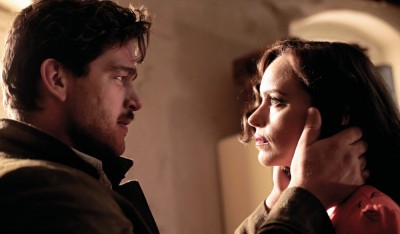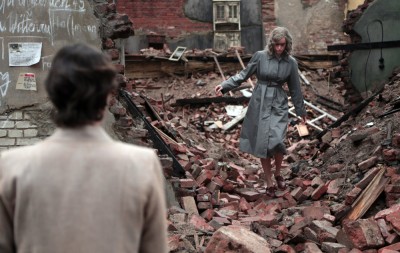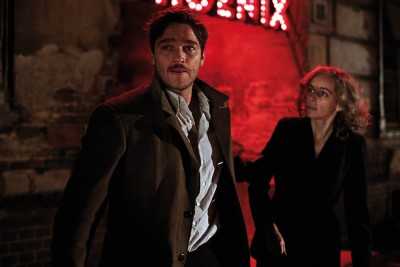Next week (July 31 at the Royal, August 7 at the Playhouse and Town Center) we’ll begin screening one of the best movies of the year, the German film noir PHOENIX. It’s set in Berlin just after the second World War and follows Nelly (the great Nina Hoss), a German Jew and concentration camp survivor. Like her country, she is scarred, her face disfigured by a bullet. After undergoing reconstructive surgery, Nelly emerges with a new face, one similar but different enough that her former husband doesn’t recognize her. Rather than reveal herself, Nelly begins a dangerous game of duplicity and disguise as she tries to figure out if the man she loves may have been the one who betrayed her to the Nazis.
Film critics are hailing the movie. In the Village Voice, Stephanie Zacharek declared the film “rapturous…ardent, urgent and smoldering…so beautifully made that it comes close to perfect.”

Director/co-writer Christian Petzold (Barbara, Yella) said this about his latest film: “The first day of shooting for PHOENIX: a birch forest, a man in Wehrmacht uniform, women in concentration camp garb. Our reference was a photograph supplied by the Shoah Foundation: a coarse-grain color picture of a woodland crossroads in impressionistic morning light. And, only at second glance, death: the corpse in the grass. Even during the shoot, we noticed that something wasn’t right. The light was good, we’d settled on the framing, it seemed like an accurate recreation of the image, but it didn’t work. The reconstruction of the horror, the cinematography in and around Auschwitz – as if we were saying, ‘Now it’s time. Now we’re going to condense the whole thing into a story and impose order on it.’ We threw away all the material from that first day of shooting.

“Raul Hilsberg wrote that the terror meted out by the Nazis and the obedient public essentially made use of well-known techniques. What was novel were the extermination camps – the industrial extermination of people. For the old techniques, there was literature, stories, songs… None of that exists for the Holocaust.
 “One text had a major influence on our preparations: Ein Liebesversuch (‘An Experiment in Love’) by Alexander Kluge. The story is set in Auschwitz. The Nazis are looking through peepholes into a sealed room. They’re observing a couple who, according to their records, used to be passionately in love. The Nazi doctors are trying to revive this love: They want the couple to sleep with each other. The goal is to establish whether the woman has been successfully sterilized. They try everything: champagne, red light, spraying them with ice-cold water – thinking that the need for warmth might drive them together again. But nothing happens – the two of them don’t look at each other. In a strange way, the Nazi doctors’ failure is a victory for love: a love lost that can’t be re-kindled by these criminals. I think that was the most significant text for us. Is it possible to leap back over the deep, nihilistic chasm torn by the National Socialists and the Germans, and to reconstruct things: emotions, love, compassion, empathy – life?
“One text had a major influence on our preparations: Ein Liebesversuch (‘An Experiment in Love’) by Alexander Kluge. The story is set in Auschwitz. The Nazis are looking through peepholes into a sealed room. They’re observing a couple who, according to their records, used to be passionately in love. The Nazi doctors are trying to revive this love: They want the couple to sleep with each other. The goal is to establish whether the woman has been successfully sterilized. They try everything: champagne, red light, spraying them with ice-cold water – thinking that the need for warmth might drive them together again. But nothing happens – the two of them don’t look at each other. In a strange way, the Nazi doctors’ failure is a victory for love: a love lost that can’t be re-kindled by these criminals. I think that was the most significant text for us. Is it possible to leap back over the deep, nihilistic chasm torn by the National Socialists and the Germans, and to reconstruct things: emotions, love, compassion, empathy – life?
“Nelly doesn’t accept stories, songs, poems claiming that love is no longer possible. She wants to turn back time. I’m interested in people who don’t accept something and, in doing so, are defiant and stubborn.”

Rosalyn Campfield liked this on Facebook.
Greg Laemmle liked this on Facebook.
Aimee Young liked this on Facebook.
The Laemmle Family is to be congratulated for keeping conematic story telling alive all these years. We are looking forward to attending today to see Phoenix.